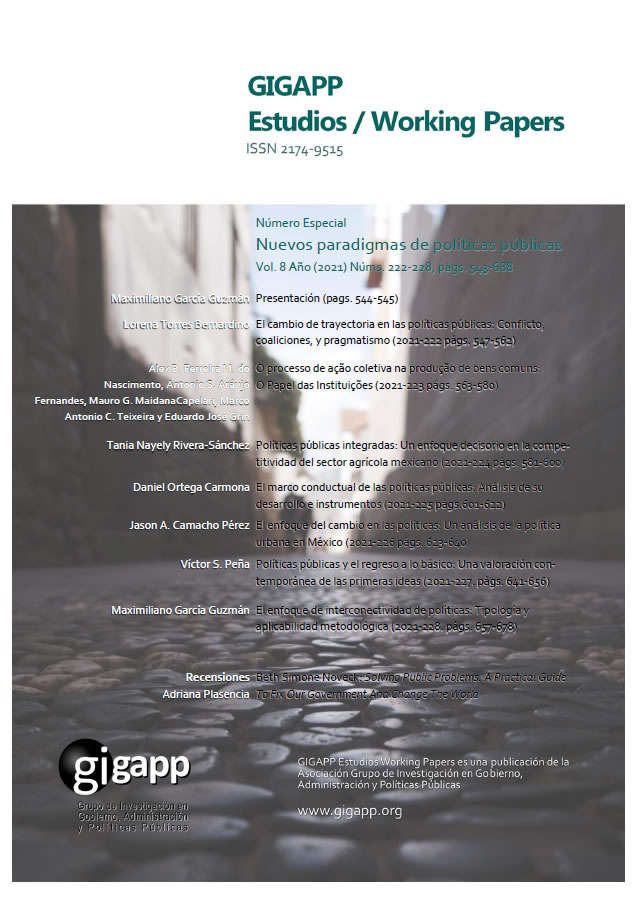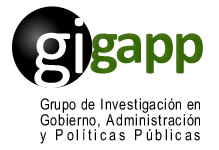El enfoque de interconectividad de políticas
Tipología y aplicabilidad metodológica
Resumen
El ciclo de políticas es una herramienta de análisis que permite simplificar y dar orden al proceso de gobierno, sin embargo, dada la complejidad del espacio público se necesitan formas alternativas para su abordaje y tratamiento, por lo que en años recientes se han generado enfoques que intentan brindar una visión más precisa y amplia de los fenómenos de la vida colectiva y del tratamiento institucional que requieren. En ese marco, se propone la utilización de una visión ya explorada por la física cuántica en la que se aborda el fenómeno del entrelazamiento de partículas que, traducido al leguaje de los estudios sobre asuntos públicos, se refiere a la premisa de que el estado de una política afecta el de otra, aún sin que tengan un vínculo aparente o sean distantes en cuanto a su temática o ámbito geográfico de aplicación. Así, además de abordar las características esenciales de esa propuesta, también se incluyen algunas reflexiones elementales sobre los tipos de interconectividad que pueden darse y su aplicabilidad metodológica en cuanto a herramienta de análisis.
Descargas
Citas
Aguilar, L. (ed.) (1992a), El estudio de las políticas públicas, México; Miguel Ángel Porrúa.
Aguilar, L. (ed.) (1992b), La hechura de las políticas, México; Miguel Ángel Porrúa.
Aguilar, L. (ed.) (1993a), La implementación de las políticas, México; Miguel Ángel Porrúa.
Aguilar, L. (ed.) (1993b), Problemas públicos y agenda de gobierno, México; Miguel Ángel Porrúa.
Böhr, N. (1935), “Can quantum-mechanical description of physical reality be considered complete?”, en Physycal Review, 48, 696-702.
Buchanan, R. (1992), “Wicked problems in design thinking”, en Design Issues, 8(2), 5-21.
Conklin, J. (2001), “Social complexity wicked problems”, en Dialogue Mapping: Building Shared Un-derstanding of Wicked Problems. Nueva York; Wiley.
Devereaux, A. (2018), “Complex and entangled public policy: Here be dragons”, en SSRN Electronic Jour-nal, https://doi.org/10.2139/ssrn.3177464
Elder, C. y Coob. R. (2007), “Formación de la Agenda. El caso de la política de los ancianos”, en Problemas públicos y agenda de gobierno, L. Aguilar (ed), México; Miguel Ángel Porrúa.
Gagnon, F., Kouri, D. y Burtan, M (2008), Integrated governance and healthy public policy: two canadian examples, Quebec, https://www.ncchpp.ca/docs/Integrated_governance_AN.pdf
Garson, D. (2007), “De la ciencia de políticas al análisis de políticas”, en El Estudio de las políticas públi-cas, L. Aguilar (ed), México; Miguel Ángel Porrúa.
Geyer, R. y Cairney, P. (2015), Handbook on complexity and public policy, Cheltenham; Edward Elgar Pu-blishing, Inc.
Griffiths, D. (2004), Introduction to quantum mechanics, Upper Saddle River, NJ; Prentice Hall.
Kumar, M. (2008), “Quantum”, en Einstein, Bohr and the great debate about the nature of reality, Icon.
Landau, M. (2007), “El ámbito propio del análisis de políticas, en El Estudio de las políticas públicas, L. Aguilar (ed), México; Miguel Ángel Porrúa.
Lasswell, H. (1970), “The emerging conception of the policy sciences”, en Policy Sciences, 1(1), 3-14, https://doi.org/10.1007/BF00145189
Lasswell, H. (1951), “The policy orientation”, en The Policy Sciences: Recent Developments in Scope and Method, D. Lerner & H. D. Lasswell (eds.), págs. 3–15, Stanford; Stanford University Press.
Lindblom, C. (1959), “The science of “muddling through”, en Public Administration Review, 19(2), 79-88, https://doi.org/10.2307/973677
Marks, P. y Gerrits, L. (2013), “Approaching Public Administration from a Complexity Perspective”, en Public Administration Review, 73(6), 898–903, https://doi.org/10.1111/puar.12145
Mendell, A. (2009), Comprehensive policies to combat poverty across Canada, by province, Quebec; Na-tional Collaborating Centre for Healthy Public Policy.
Méndez, J. (2015), Análisis de políticas públicas: Teoría y casos, México, D.F.; El Colegio de México, A.C.
Méndez, J. (2020), Políticas públicas: Enfoque estratégico para América Latina, Ciudad de México; Fondo de Cultura Económica.
Mittelstraß, J. (2015), “Complexity, Reductionism, and Holism”, en Complexity and analogy in science: theoretical, methodological and epistemological aspects, W. Arber, J. Mittelstraß, y M. Sánchez So-rondo (eds.), págs 45–53, Libreria Editrice Vaticana.
Morçöl, G. (2013), “A complexity theory for public policy”, en A Complexity Theory for Public Policy, Tay-lor y Francis, https://doi.org/10.4324/9780203112694
Ostrom, E. (2015), Comprender la diversidad institucional, México; Fondo de Cultura Económica y Univer-sidad Autónoma Metropolitana.
Pardo, M. (2009), La modernización administrativa en México, 1940-2006, Ciudad de México; El Colegio de México.
Pardo, M., Dussauge-Laguna, M. y Cejudo, G. (2018), Implementación de políticas públicas: Una antolo-gía, México, D.F.; Centro de Investigación y Docencia Económicas.
Peres, A. (2002). “Composite systems”, en Quatum Theory: Concepts and Methods, págs. 115-147, https://doi.org/10.1007/0-306-47120-5_5
Pérez, G. y Maldonado, C. (2015), Panorama de los sistemas nacionales de monitoreo y evaluación en América Latina, México, D.F.; Centro de Investigación y Docencia Económicas.
Rabotnikof, N. (2005), En busca del hogar público, México; Instituto de Investigaciones Filosóficas, Uni-versidad Nacional Autónoma de México.
Rabotnikof, N. (1997), “El espacio público y la democracia moderna”, en Colección Temas de la Democra-cia, Serie Ensayos, número 1. México; Instituto Federal Electoral.
Rein, M. y Rabinovitz F. (1978), “La implementación: una perspectiva teórica. Entre la intención y la ac-ción”, en La implementación de las políticas, L. Aguilar (ed), México; Miguel Ángel Porrúa.
Derechos de autor 2021 Maximiliano García Guzmán, Dr. (Autor/a)

Esta obra está bajo licencia internacional Creative Commons Reconocimiento-NoComercial-CompartirIgual 4.0.
Aquellos autores/as que tengan publicaciones con esta revista, aceptan los términos siguientes:
a. Los autores/as conservarán sus derechos de autor y garantizarán a la revista el derecho de primera publicación de su obra, el cuál estará simultáneamente sujeto a la Licencia de reconocimiento de Creative Commons Attribution-NonCommercial-ShareAlike 4.0 International (CC BY-NC-SA 4.0) que permite a terceros compartir la obra siempre que se indique su autor y su primera publicación esta revista.
Con esta licencia de acceso abierto, los lectores (usuarios) pueden:
- Compartir — copiar y redistribuir el material en cualquier medio o formato
- Adaptar — remezclar, transformar y construir a partir del material
Bajo los siguientes términos:
-
Atribución — usarios deberán dar crédito de manera adecuada, brindar un enlace a la licencia, e indicar si se han realizado cambios. Puede hacerlo en cualquier forma razonable, pero no de forma tal que sugiera que usted o su uso tienen el apoyo de la licenciante.
-
NoComercial — usuarios no puede hacer uso del material con propósitos comerciales.
-
CompartirIgual — Si remezcla, transforma o crea a partir del material, usuarios deben distribuir su contribución bajo la misma licencia del original.
-
Sin restricciones adicionales: los usuarios no pueden aplicar términos legales o medidas tecnológicas que restrinjan legalmente a otros de hacer cualquier cosa que permita la licencia.
b. Los autores/as podrán adoptar otros acuerdos de licencia no exclusiva de distribución de la versión de la obra publicada (p. ej.: depositarla en un archivo telemático institucional o publicarla en un volumen monográfico) siempre que se indique la publicación inicial en esta revista
c. Se permite y recomienda a los autores/as difundir su obra a través de Internet (p. ej.: en archivos telemáticos institucionales o en su página web) antes y durante el proceso de envío, lo cual puede producir intercambios interesantes y aumentar las citas de la obra publicada. (Véase El efecto del acceso abierto).



